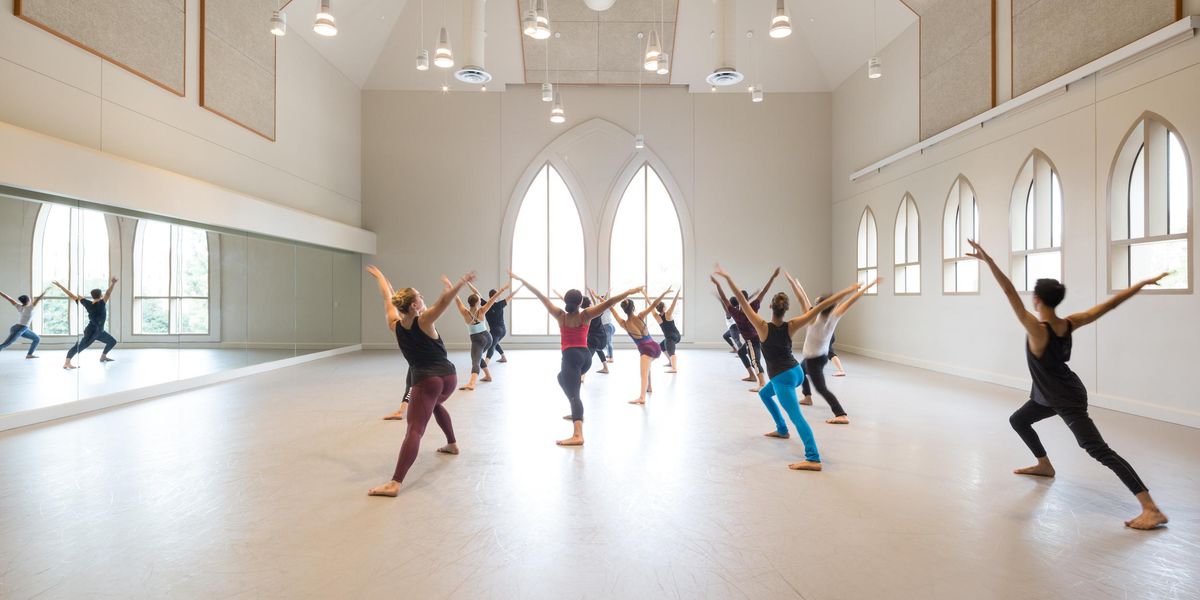Thodos Dance Chicago
Harris Theater for Music and Dance, Chicago
March 2–3, 2013
Pictured at right: Alissa Tollefson as Anne Sullivan and Jessica Miller Tomlinson as Helen Keller.
Who doesn’t love a good story, one that still enthralls, no matter how many times we’ve heard it before? Take the story of Hellen Keller, the subject of Thodos Dance Chicago’s premiere, A Light in the Dark, choreographed by Ann Reinking and Melissa Thodos. The triumphant story of a deaf and blind child and the undying devotion of her gifted teacher has been told many times, most memorably as the play and movie The Miracle Worker. This may be the first time, however, that anyone has attempted to tell it through the medium of dance.
Reinking and Thodos’ seamless integration of theatrical blocking with choreographed interludes made for compelling storytelling. The larger-than-life gestural language of the choreography weaves a tale with an almost mythic tone that gives us new insight into Helen Keller’s world.
Helen’s parents (Cara Carper and Jon Sloven), older brother (Brian Hare), and maid (Tiffany Krause) all move in linear, balletic combinations that approximate societal formality, while Anne Sullivan (Alissa Tolefson) and her brother Jimmy’s (John Cartwright) movement takes on a “slang” that depends on off-center distortions and twists. In a masterful artistic illusion, Helen (Jessica Miller Tomlinson) has a movement idiom all her own that appears freeform, impulse-driven, and completely unschooled.
The choreography renders each character as a distinct, three-dimensional personality. Anne Sullivan’s richly layered “monologues,” performed with authority and emotional depth, frame the story’s opening and conclusion with strong torso isolations that depart from the upright restraint of her movement in scenes with the Keller family.
Bruce Wolosoff’s original score lends a once-upon-a-time melodic backdrop that evokes the gentility of late 19th-century society in the American South, yet supports the characters’ contrasting motifs with contemporary phrasing.
A pinpoint of light opens the first episode, “Asylum,” in the center of darkness, evoking memory of time past as well as Anne’s encroaching loss of vision. Set to a voice-over of Anne telling her dying brother Jimmy that she will be there for him, the ensuing duet has Anne lifting, catching, and supporting the frail Jimmy in her arms, on her back, and across her body. Jimmy’s rag-doll body and collapsible limbs thwart his efforts to move on his own. But when he does, with Tolefson’s help, he takes to the air with weightless abandon.
Brian Hare, Jessica Miller Tomlinson and Alissa Tollefson in
A Light in the Dark, the story of Helen Keller and Anne Sullivan.
Photo by
Todd Rosenberg for Cheryl Mann Photography, Courtesy Thodos.
Dance “dialogues” between the “speaking” characters of Helen’s parents and volatile older brother James digress into conventional ballet combinations that suggest conformity to behavioral norms. In contrast, the interactions of mute Helen with Anne create a unique body language—softer and less linear, that draws from impulse-driven, modern-dance roots. Brian Hare’s rebellious outbursts as James interrupt in sharp jabs, buoyant sissones, pirouettes, and grand jetés.
Helen’s parents, brother, and Anne set Helen’s flailing body afloat in space, accentuating Helen’s loss of spatial orientation.
The dancers deserve credit for the strength of their dancing and the honesty and eloquence of their acting. We truly believe Jessica Miller Tomlinson’s Helen is the bright, petulant little girl we know Helen to have been, and we never doubt that she can neither see nor hear. Tomlinson’s fingers “speak” with striking articulation, and the untamed rawness of Helen’s curiosity, confusion, rage, and affection come across as spontaneous and unstudied. The spare but effective use of voice, integrated with movement, builds dramatic tension as Anne speaks the words for the hand signs she is teaching Helen. In the climactic scene, Helen not only signs but voices the word for “water” for the first time. In a final, emotional solo, Anne plunges to the floor and reaches into the air with arms beseeching and body capitulating. Her gratitude, relief, and exhaustion close the curtain on a riveting story that continues to resonate in our hearts.
Three additional pieces made up the second half of the program: Brian Enos’ Lullaby (company premiere), KT Nelson’s rest is not always possible (2012), and Thodos’ Subtle Passages (2012).
Photo at top by
Todd Rosenberg for Cheryl Mann Photography, Courtesy Thodos Dance Chicago.




